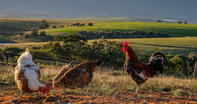You need to be calculated if you want to make it as a poultry breeder, as the market for commercial lines is dominated by well-established businesses.

Mick Bosch of Boschveld Chickens says there are two challenges when focussing on this market: Firstly it is near impossible for a new entrant to compete with well-established market rulers; and secondly commercial poultry lines only produce well under strictly controlled environments that are extremely expensive to establish – think millions of Rand.
Informal Market

A better idea would be to target the market for indigenous or dual breeds, such as the Boschveld, Australorp, Koekoek and Island Red.
These breeds may not grow as quickly as commercial lines and they may also reach the point of laying later and lay fewer eggs, but they are more disease resistant and able to thrive in much harsher conditions than their commercial brothers – even if they are left to roam freely as village chickens receiving hardly any inputs.
These birds, according to Bosch, are in high demand as free-range chicken, for village chicken production and small rural operations. At the time of writing, he was struggling to keep up with the demand in the African market, so there is also good export potential for these birds.
Bosch advised farmers first to test the market and start small, say with about 500 chickens, and then grow the business as demand grows. Starting the business too big may result in a farmer sitting with “unwanted birds”.
The chicks can be sold when they are a day old to broiler producers or additional value can be added to the birds by raising them until they are at the point of lay, somewhere between 18 weeks and 21 weeks old depending on the breed. Cockerels can be sold as live chickens when they are about 12 weeks old.
Value-Adding
The breeder birds and chicks will perform best when they receive a diet aimed at enhancing their performance, but will still do okay if they are left to scavenge for themselves. Birds that are left to scavenge and roam everywhere without any boundaries, are however more vulnerable to diseases, injuries and predators than birds that are produced in semi-intensive systems.
Value can be added to day old chicks by vaccinating them against Infectious Bronchitis and Newcastle Disease before selling them. Layers should be vaccinated against Infectious Bursal Disease (Gumboro) and Coryza before they are sold.
Supplying the market with strong healthy chicks that are vaccinated against the major disease risks, will help to create a positive reputation for the business and result in repeat sales and new clients thanks to the impact of “word of mouth” advertising.
Remember to carefully manage your choice of cockerel to use on the hens to prevent inbreeding, which will overtime have a negative impact on production, reproduction and result in deformities.
By Glenneis Kriel